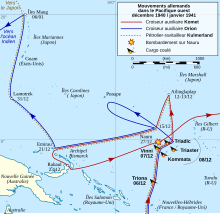
Orion (HSK-1) was an auxiliary cruiser of Nazi Germany's Kriegsmarine which operated as a merchant raider in World War II. Blohm & Voss built her in Hamburg in 1930–31 as the cargo ship Kurmark. The navy requisitioned her at the start of World War II, had her converted into the auxiliary cruiser Orion, and commissioned her on 9 December 1939. Known to the Kriegsmarine as Schiff 36, her Royal Navy designation was Raider A. She was named after the constellation Orion.

Jun'yō Maru (順陽丸) was a cargo steamship that was built in Scotland in 1913, served a succession of British owners until 1927, and was then in Japanese ownership until a Royal Navy submarine sank her in 1944.

Tango Maru (丹後丸) was a cargo motor ship that was built in Germany in 1926 and sunk off the coast of Bali in 1944. She was launched as Rendsburg for the Deutsch-Australische Dampfschiffs-Gesellschaft (DADG), which in 1926 merged with Hamburg-Amerikanische Packetfahrt-Actien-Gesellschaft (HAPAG).
SS Cambridge was a refrigerated steam cargo liner that was built in Germany for the Hamburg America Line. She was launched in 1916 as Vogtland, but after the 1919 Treaty of Versailles the United Kingdom took her as war reparations and sold her to the Federal Steam Navigation Company, who renamed her Cambridge. She operated between Britain and Australasia until 1940, when a German mine sank her off the coast of Australia.
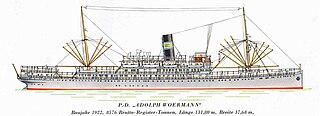
SS Adolph Woermann was a German steam ocean liner built in 1922 by Blohm & Voss in Hamburg for the shipping lines Woermann-Linie (WL) and German East Africa Line and named after German merchant, ship owner and politician Adolph Woermann, and the fourth ship of the same name.

Shin'yō Maru was a cargo steamship that was built in 1894, had a fifty-year career under successive British, Australian, Chinese and Greek owners, was captured by Japan in the Second World War, and sunk by a United States Navy submarine in 1944.

MV Spreewald was a Hamburg America Line (HAPAG) cargo motor ship that was launched in 1922 and sunk in a friendly fire incident in 1942. She was renamed Anubis in 1935, and reverted to her original name Spreewald in 1939.
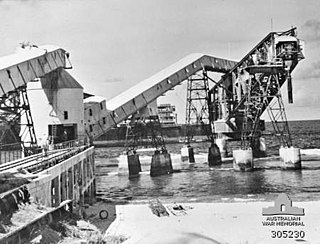
The German attacks on Nauru refers to the two attacks on Nauru in December 1940. Nauru is an island country in Micronesia, a subregion of Oceania, in the Central Pacific. These attacks were conducted by auxiliary cruisers between 6 and 8 December and on 27 December. The raiders sank five Allied merchant ships and inflicted serious damage on Nauru's economically important phosphate-loading facilities. Despite the significance of the island to the Australian and New Zealand economies, Nauru was not defended and the German force did not suffer any losses.

SS Ypiranga was a cargo liner that was launched in Germany in 1908 for the Hamburg America Line (HAPAG). In 1919 the United Kingdom seized her for World War I reparations. In 1921 Anchor Line acquired her and renamed her Assyria. In 1929 the Companhia Colonial de Navegação (CCN) bought her and renamed her Colonial. In 1950 she was sold for scrap, but she sank off the coast of Scotland while being towed to a scrapyard.

USS General W. C. Gorgas (ID-1365) was a cargo liner that was launched in Germany in 1902 as Prinz Sigismund for the Hamburg America Line. In 1917 the USA seized her and renamed her General W. C. Gorgas. In 1945 she was transferred to the Soviet Union, which renamed her Mikhail Lomonosov. She was scrapped in March 1958.
SS Hertford was a refrigerated cargo steamship that was launched in Germany in 1917, seized by the United Kingdom in 1920 as World War I reparations, and sunk by a U-boat in 1942 with the loss of four members of her crew.
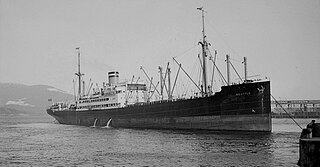
MS Seattle was a Hamburg America Line (HAPAG) cargo liner that was launched in 1928. Her regular route was between Hamburg and Vancouver via the Panama Canal and the West Coast of the United States.
SS Santa Fé was a German refrigerated cargo steamship. She is now a Black Sea shipwreck and part of her cargo is of interest to marine archaeologists.
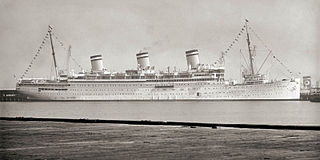
SS Reliance was one of a pair of transatlantic steam ocean liners that were launched in 1914 in Germany for the Hamburg America Line (HAPAG), sold to a Dutch shipping line in 1916, and seized by the United States as World War I reparations in 1922. United American Lines (UAL) operated her until 1926, when HAPAG bought her back.
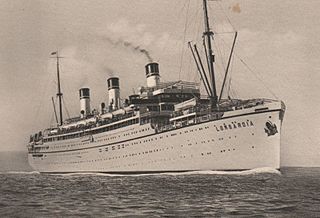
SS Lombardia was one of a pair of transatlantic steam ocean liners that were launched in 1914 in Germany for the Hamburg America Line (HAPAG), sold to a Dutch shipping line in 1916, and seized by the United States as World War I reparations in 1922. United American Lines (UAL) operated her until 1926, when HAPAG bought her back.
SS Alesia was a German-built merchant steamship. She was completed in 1896 as Bangalore, but renamed Alesia in 1897 when Hamburg America Line (HAPAG) bought out her owners. The British government in India seized her in the First World War. She was scrapped in the 1920s.
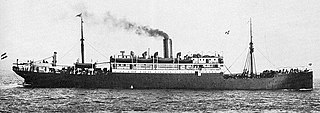
SS Prinz Oskar was a twin-screw cargo liner that was launched in Germany in 1902 for Hamburg America Line (HAPAG). She served various transatlantic routes between Europe and the Americas until the First World War began.

SS Lima was a passenger and cargo steamship that was launched in England in 1907 as Westerwald for Hamburg America Line (HAPAG)'s Caribbean services. Portugal seized her in 1916, renamed her Lima, and used her as a troopship. By 1926 the Empresa Insulana de Navegação (EIN) had bought her for its service to Madeira and the Azores. She was scrapped in Portugal in 1969.
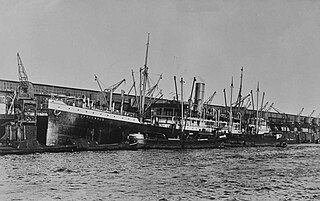
HMS Lucia was a steamship that was launched in England in 1907 as the passenger and cargo ship Spreewald for Hamburg America Line (HAPAG)'s Caribbean services. The Royal Navy captured her in 1914, and renamed her Lucia. Elder Dempster Lines managed her until 1916, when she was converted into the submarine depôt ship HMS Lucia.

SS Frankenwald was a passenger and cargo steamship that was launched in England in 1908 for Hamburg America Line. In 1919 France seized her as part of Germany's World War I reparations. In 1920 the Compagnie de Navigation Paquet bought her and renamed her Tadla. A Turkish shipowner bought her in 1934 and renamed her Tari. She passed through a succession of Turkish owners, and was scrapped in 1967.


